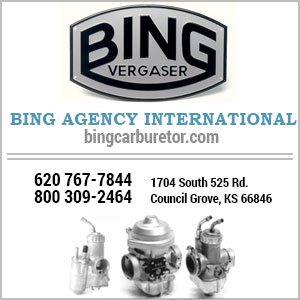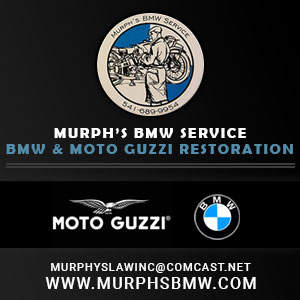R75/6 Fork Dampers
I want to remove the Race Tech valves installed in my R75/6. Because of the mods required to install them, that means that I need a new pair of damper rods. Perusing e'bay and other sites, I see two styles (pictures attached). The most noticeable difference being the addition of the aluminum bushing on the one titled "damper style 2", which looks like the current parts fiche. But supposedly both fit the R60/75/90/? models. Does anyone know the history of these two styles: which came first, why the change, is one type functionally superior to the other?
Thanks,
Kevin
This is pure speculation on my part, which I am loathe to engage in as a general rule. Your /6 has the type of fork that requires the end of the damping rods to hold on to the sliders with threaded nipples that protrude thru the bottom cap of the fork leg. Some later versions attach to the sliders with a bolt that threads in to the bottom of the damping rod. Also, the fork tubes of my '85 R80RT are of a slightly larger diameter than on my /5. The /5 and /6 fork internals are pretty much the same. So, there might be a size difference involved there as well. The pictures attached "look" like the dampers inside early style forks to me. In the picture, It appears that the threaded nipple end stop and the spring and ball valve bits are not present inside the damping rod.
former Airmarshal, IL.
Kevin,
Could you speak to your experience with the emulators and revised damping rods?
Thinking of trying this versus "anti-dive" springs or other mods.
Thanks,
George
Where to start....
There are multiple iterations of the installation instructions floating about. Per the latest ones I got from Matt Wiley:
- You increase the existing holes in the damper rods to 1/4".
- Your OEM rods will have four at the bottom, and another 2/4/5 midway up the rod (depending on the vintage of your rods). So you will enlarge and add holes until you have a total of 10 (four at the bottom and six midway up). The RT valves are picky about unrestricted oil flow. Make sure you chamfer the holes to remove any burrs and help oil flow smoothly.
Otherwise the instructions are pretty straight forward:
- Remove the check ball and spring at the bottom.
- Cut the entire top off of the cap at the top. Don't just drill a hole down through the middle and leave the hex part in place.
When I bought my kit, it didn't come with the "silver" spring for the RT valves. If you don't get them, call RT and have them sent. Every article I've seen says they ended up using the silver springs. I did too. The instructions have you start with three turns of preload on the valve springs; that is where I ultimately ended up.
The instructions say to use 15W fork oil. And unfortunately, 15W isn't 15W across brands. The closest I have found as a way to equate brands is to go by the cST value at 40 degrees C. The manufacturers can tell you what theirs is. I ultimately ended up with 10W BelRay oil. I have the oil level set at 150mm below the top of the fork tube.
My kit came with 85# fork springs (1@80#, 1@90#). They were too stiff. I changed them for 75# (1@80#, 1@70#). They were still too stiff. Ultimately I would up with a pair of 65# springs from Sonic Springs (sonicsprings.com).
I can't remember how long my PVC preload pieces are, but you adjust them as needed for proper sag.
All of this said, how do they work? On smooth roads, the bike definitely corners more solidly than stock. But...I don't live near a big city, so the country roads I spend most of my time on are rough, patched, cracked, .... On those roads there is a subtle chatter in the bars that eventually becomes annoying. Smoother than the ride on my Norton, but not near the floating ride of my R1200GS. So yea, I'm spoiled. If I rode aggressively, did track days, of rode smooth roads, I'd probably keep the RT valves, but I don't, so they go.
Hope this helps,
Kevin
Where to start....
There are multiple iterations of the installation instructions floating about. Per the latest ones I got from Matt Wiley:
- You increase the existing holes in the damper rods to 1/4".
- Your OEM rods will have four holes at the bottom, and another 2/4/5 midway up the rod (depending on the vintage of your rods). So you will enlarge and add holes until you have a total of 10 (four at the bottom and six midway up). The RT valves are picky about unrestricted oil flow. Make sure you chamfer the holes to remove any burrs and help oil flow smoothly.
Otherwise the instructions are pretty straight forward:
- Remove the check ball and spring at the bottom.
- Cut the entire top off of the cap at the top. Don't just drill a hole down through the middle and leave the hex part in place.
When I bought my kit, it didn't come with the "silver" spring for the RT valves. If you don't get them, call RT and have them sent. Every article I've seen says they ended up using the silver springs. I did too. The instructions have you start with three turns of preload on the valve springs; that is where I ultimately ended up.
The instructions say to use 15W fork oil. And unfortunately, 15W isn't 15W across brands. The closest I have found as a way to equate brands is to go by the cST value at 40 degrees C. The manufacturers can tell you what theirs is. I ultimately ended up with 10W BelRay oil. I have the oil level set at 150mm below the top of the fork tube.
My kit came with 85# fork springs (1@80#, 1@90#). They were too stiff. I changed them for 75# (1@80#, 1@70#). They were still too stiff. Ultimately I would up with a pair of 65# springs from Sonic Springs (sonicsprings.com).
I can't remember how long my PVC preload pieces are, but you adjust them as needed for proper sag.
All of this said, how do they work? On smooth roads, the bike definitely corners more solidly than stock. But...I don't live near a big city, so the country roads I spend most of my time on are rough, patched, cracked, .... On those roads there is a subtle chatter in the bars that eventually becomes annoying. Smoother than the ride on my Norton, but not near the floating ride of my R1200GS. So yea, I'm spoiled. If I rode aggressively, did track days, or rode smooth roads, I'd probably keep the RT valves. But I don't, so they go.
Hope this helps,
Kevin
Thank you, Kevin - what a great, detailed piece for the archives.
George
(if your Norton has not been modified, and you may well know of this, there is also an emulator "fix" , which was a great improvement on my last Commando)
- 27 Forums
- 1,801 Topics
- 10.2 K Posts
- 3 Online
- 5,524 Members





